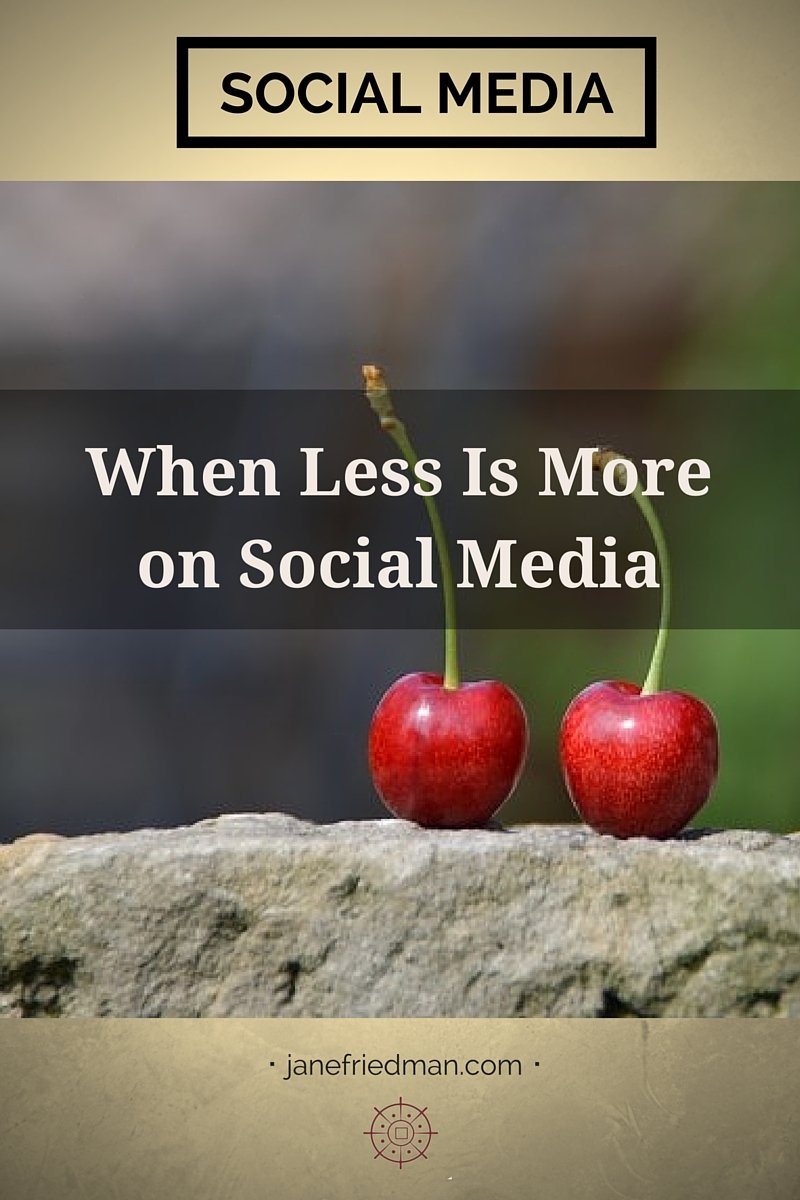
Today’s guest post is from social media expert Chris Syme (@cksyme). Learn about her June master class.
Social media boasts some pretty staggering numbers: nearly two-thirds of American adults use social media. And 70 percent of those users ages thirteen and up are on Facebook, according to the Pew Research Center.
Authors feel the steady pressure to be on social media channels promoting themselves, promoting their books, and searching for those ever-elusive readers. Some marketers tout it like it’s a magic pill, encouraging authors to be in every possible corner of the social media universe. After all, you don’t want to miss anybody, right?
The trouble with this advice is that it is antithetical to the present marketing culture. Marketing in this day and age is not about casting a wide net to get all the fish. It’s about knowing who your audience is, understanding where the best spots to find them are, and going narrow with the best channels for optimum results. If you want maximum results from your social media channels, less is more.
Fewer Channels Means More Engagement
I have long been an advocate of being on fewer social media channels to maximize engagement. There are several reasons for that, but I’ll give you the main three:
- Finding where your audience members spend the most time makes it easier to target them.
- Spending time on channels that grab less than 25 percent of the users online is a waste unless it is a niche channel specific to your audience.
- Every channel is not conducive to selling. Choose channels where you can engage and sell.
When you take the time to really focus on who your audience members are, what their engagement patterns are, where they engage, and where they are buying, you get a pretty good idea of where you should be.
Because people are inundated with information on social media—much of it the same on all channels—they are looking for places where a culture of connection and sharing has been established. They do not want to wade through endless posts that sell books or products.
Amy Porterfield, a Facebook marketing expert, analyzed over a million high-engaging Facebook posts and found these six content types were most engaging:
- Posts that give: offers, deals, and contests that everyone can benefit from
- Posts that advise: tips, especially about problems everyone encounters
- Posts that warn: dangers that everyone faces (scams and the like)
- Posts that amuse: funny or entertaining pictures or quotes
- Posts that inspire: quotes, videos, and images that make people feel good and valued for who they are
- Posts that amaze: pictures, stories, and videos of amazing people and events
According to Porterfield’s research, people want to feel one of four things when they engage with social media: happy, informed, inspired, or supported.
If the majority of your social media content hits on all those cylinders, you don’t need to worry about being everywhere or asking people to buy your book. As Mark Schaefer teaches in his book The Content Code, the law of internet marketing reciprocity will earn you the right to sell your products if you offer enough value to your fans.
The bottom line: social media is not about getting everybody’s attention everywhere. It’s about engaging potential and current fans in one or two spots where they are consistently present and interacting. Those are your primary social media channels. All the rest are secondary channels and only require an outpost strategy that aims people to the channels where the action is.
What Is an Outpost Channel?
An outpost channel has some of the following characteristics:
- It is populated by people you are already effectively reaching on another channel.
- It does not foster a commerce culture, or does not offer tools such as ads and apps that help you sell books or capture emails.
- Less than 25 percent of the adult population uses the channel (see Pew Internet for latest numbers).
- It is a channel where you post or interact less than the prescribed amount for ideal engagement.
There are some exceptions to these guidelines. Two major ones:
- Genre-specific guidelines: LinkedIn can be a must for nonfiction writers selling courses or trying to establish an expertise. It is an unnecessary channel for fiction writers.
- Demographic exceptions: If you are a YA or New Adult writer, you should consider the top channels in that demographic (such as Tumblr or Instagram) when you are looking to establish primary channels.
What Is a Primary Channel?
To identify your one or two primary channels to engage, consider:
- audience demographics that match your books
- the channel’s ability to sell
- your skill set to implement the content that spells success on that channel.
For example, even though YouTube has the potential to sell books, if you don’t know how to produce good videos, use YouTube to establish sales channels, or have a detailed plan for gaining subscribers (YouTube’s magic formula), you will fail there.
You should identify one or two channels and work to establish a community—that means a community that you interact with as people, not as sales figures. Once you’ve identified your primary channels, you can set up a plan for maximum engagement. Use an 80-20 content formula for giving value (80 percent) to selling (20 percent). Yes, you still want to sell, but because you have loyal fans, you don’t need a constant parade of sales messages. Also, if you are engaging on a channel such as Facebook, you can rely somewhat on the presence of commerce tools to present an “opportunity” for fans to buy when they are ready.
Note from Jane: Chris Syme is offering a June master class that teaches you how to set up an outpost strategy. Find out more.

Chris Syme is a 20-year veteran of the communications and marketing industry and is the founder of CKSyme Media Group. She is an author and speaker on the topics of social media marketing and reputation management. She is a former university media relations professional and crisis management consultant for college athletic departments, businesses, and sports event venues. Chris also co-hosts the popular Smarty Pants Book Marketing Podcast with her daughter, USA Today bestselling author R.L. (Becca) Syme.

[…] view post at https://janefriedman.com/less-is-more-social-media/ […]
[…] Social media expert Chris Syme explains why less is more in social media, and how to make the most use of primary and secondary social media channels. […]
Less is more, I love it.
I’m a big fan of connecting and engaging readers versus stone-cold marketing schemes.
I particularly appreciated targeting a specific audience instead of spreading ourselves too thin across the abyss of social media. I just interviewed an indie author who spends thousands of dollars on book promotion. I’m starting to think he has the wrong marketing strategy.
Great post, thanks for sharing!
Benjamin
Thanks Benjamin–Glad you found it helpful. I think the paranoia about the need to be everywhere is common today. What we’re missing out on is the reality that fans are looking to connect with us and get value from that connection first. Then, we don’t have to work so hard at selling–they will reciprocate the value we are giving them. Also, it is just such a time saver to find one or two places to connect and then just have an outpost presence everywhere else. I talked to an indie yesterday that said this whole process is saving her about ten hours a week she can now devote to writing!
Chris – the title of this blog post alone drove me to your webinar (purchased/registered – though I’m moving on the 27th, and might not be able to attend the live webcast… drats).
So much of social media – to my ears/eyes – feels forced and inauthentic. So if there’s a “less is more” approach, albeit that feels authentic, I’m in!
Looking forward.
Awesome Avrum. If you can’t be there live and have questions after, you can just email me. My contact info will be in the class. There is definitely a less is more approach to social media but it does involve being a human and building authentic connections. There still has to be selling–social media is marketing. But it’s the ratio: you need to be giving value more than you sell. Looking forward to seeing you there as well.
Love this! I have been feeling so overwhelmed with social media, how much to post, where to post etc. This has helped clarify it all for me, and now I have a plan! Thank you
Awesome Rachel–That is why I wrote the post. Glad it helped.
[…] When Less Is More on Social Media (Jane Friedman) Authors feel the steady pressure to be on social media channels promoting themselves, promoting their books, and searching for those ever-elusive readers. Some marketers tout it like it’s a magic pill, encouraging authors to be in every possible corner of the social media universe. After all, you don’t want to miss anybody, right? […]
[…] on social media. Clare Langley-Hawthorne discusses social media etiquette and Chris Syme reveals when less is more on social media, while Anne R. Allen follows up her previous post with 8 more social media scams writers should […]
I have a love-hate relationship with my Twitter account. I have 15k followers but wonder about their value. Some authors I know swear by it; others barely touch it. I feel it’s harder to make an impression there versus the more engaging tone of FB. I’d love to kill the account but don’t want to be too hasty. {sigh}
Jennifer–Rather than killing your account I suggest that you turn it into a social media outpost. It’s fairly easy to do. When you consider that almost 45% of the people with Twitter accounts never tweet, lack of engagement there is a conundrum. Maintaining a presence there is a good idea for discoverability. You cover photo and pinned tweet can send them to a place where you are engaging people.
Thanks for the advice. I just discovered your blog today via a post on FB someone shared. really love it 🙂
Thanks for a great article Chris. What do you recommend to newbies (aka unpublished aspiring authors) like me who have no social media experience. Where to start? (Big question I know). I’m writing YA fiction. Thanks again.
First-congrats on starting your author journey and good luck! I recommend getting a website, building an email list, following YA book reviewers on YouTube and Tumblr, following other YA authors to start building a network, and setting up a Facebook author page–probably in that order. But above all, write, write, write.
[…] you read this latest article by Jane Friedman When Less is More on Social Media people spend a lot of time trying to feel inspired, engaged and […]